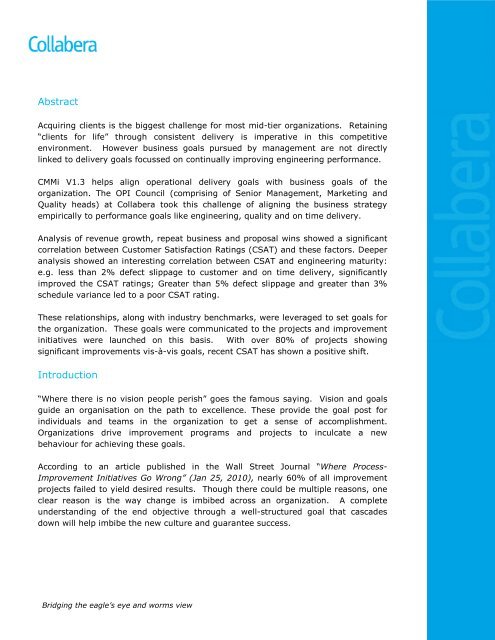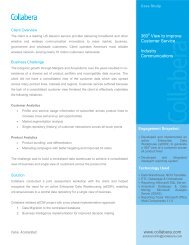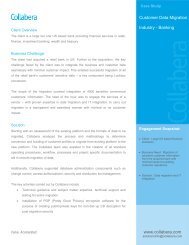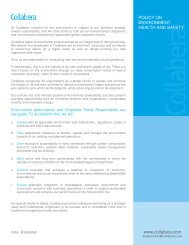BRIDGING THE EAGLE'S EYE AND WORM'S VIEW - Collabera
BRIDGING THE EAGLE'S EYE AND WORM'S VIEW - Collabera
BRIDGING THE EAGLE'S EYE AND WORM'S VIEW - Collabera
Create successful ePaper yourself
Turn your PDF publications into a flip-book with our unique Google optimized e-Paper software.
Abstract<br />
Acquiring clients is the biggest challenge for most mid-tier organizations. Retaining<br />
“clients for life” through consistent delivery is imperative in this competitive<br />
environment. However business goals pursued by management are not directly<br />
linked to delivery goals focussed on continually improving engineering performance.<br />
CMMi V1.3 helps align operational delivery goals with business goals of the<br />
organization. The OPI Council (comprising of Senior Management, Marketing and<br />
Quality heads) at <strong>Collabera</strong> took this challenge of aligning the business strategy<br />
empirically to performance goals like engineering, quality and on time delivery.<br />
Analysis of revenue growth, repeat business and proposal wins showed a significant<br />
correlation between Customer Satisfaction Ratings (CSAT) and these factors. Deeper<br />
analysis showed an interesting correlation between CSAT and engineering maturity:<br />
e.g. less than 2% defect slippage to customer and on time delivery, significantly<br />
improved the CSAT ratings; Greater than 5% defect slippage and greater than 3%<br />
schedule variance led to a poor CSAT rating.<br />
These relationships, along with industry benchmarks, were leveraged to set goals for<br />
the organization. These goals were communicated to the projects and improvement<br />
initiatives were launched on this basis. With over 80% of projects showing<br />
significant improvements vis-à-vis goals, recent CSAT has shown a positive shift.<br />
Introduction<br />
“Where there is no vision people perish” goes the famous saying. Vision and goals<br />
guide an organisation on the path to excellence. These provide the goal post for<br />
individuals and teams in the organization to get a sense of accomplishment.<br />
Organizations drive improvement programs and projects to inculcate a new<br />
behaviour for achieving these goals.<br />
According to an article published in the Wall Street Journal “Where Process-<br />
Improvement Initiatives Go Wrong” (Jan 25, 2010), nearly 60% of all improvement<br />
projects failed to yield desired results. Though there could be multiple reasons, one<br />
clear reason is the way change is imbibed across an organization. A complete<br />
understanding of the end objective through a well-structured goal that cascades<br />
down will help imbibe the new culture and guarantee success.<br />
Bridging the eagle’s eye and worms view














